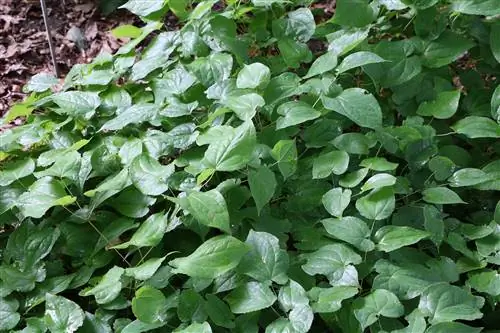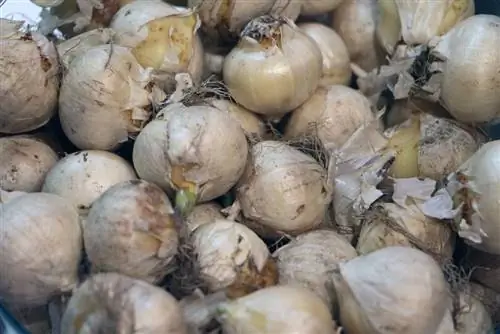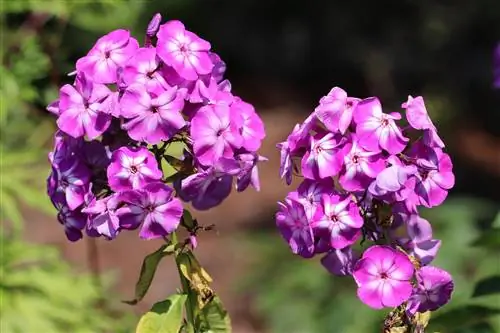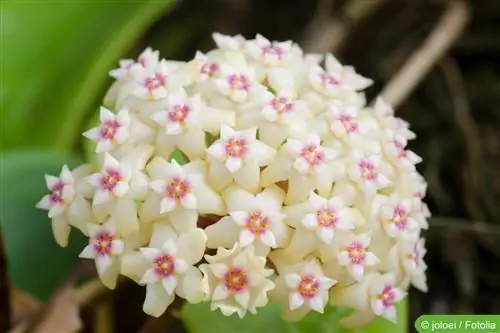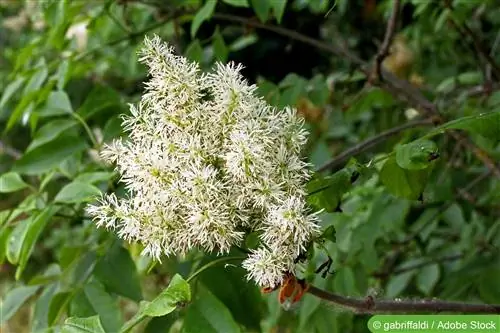- Author admin [email protected].
- Public 2023-12-17 03:39.
- Last modified 2025-06-01 06:48.
Light-poor areas in the garden don't have to look dreary. The elf flower loves the shade! Discover the magical plant with its delicate flowers and leaves reminiscent of small hearts.
Elf Flower - Profile
The plant deserves its name because its delicate flowers are reminiscent of graceful elves in fairy tales. In 2014, the beautiful shade plant was voted perennial of the year. Almost sixty different species of the plant, which belongs to the barberry family, are known. Fairy flowers are often offered under their scientific name Epimedium. But the magical plant has even more nicknames, for example goat root, goat weed, sock flower or bishop's cap.
- deciduous or evergreen plants
- Stem bare, covered with scales underneath
- Leaves heart-shaped
- Blossom in early summer
- Flower clusters with several individual flowers
- Flowers with typical, long spur
- Flower colors: white, pink, yellow, red, violet, partly two-tone
- Capsule fruits with few seeds
- durable, robust
- hardy
- Growth height about 10 to 30 centimeters
- all parts of the plant slightly poisonous
- bee-friendly
Location
The perfect location for the magical elf flowers is shady to partially shaded. The carpet-forming plants develop their beauty under trees or on shady beds. They can't tolerate the sun.
Note:
Elf flowers are ideal for growing in containers. Place the pot in a location with little sun and keep the substrate moist.
Plants
The best time to plant elf flowers is autumn. The still warm soil supports the growth of the young plants. Alternatively, you can plant the ground cover in spring. However, the plants only bloom the following year.
Instructions:
- Dig planting holes 20 to 30 centimeters apart.
- Mix the excavated soil with compost or horn shavings.
- Place the plants, still potted, in a container with water. When no more air bubbles appear, the plant is ready for planting.
- Take the plant out of the pot and place it in the planting hole.
- Fill up the soil-compost mixture.
- Water the freshly planted elf flower thoroughly.
- Cover the root area with leaves.
Tip:
Plant Epimedium in groups. You can combine different colored varieties. A dense carpet quickly develops.
Soil and bed partners
Epimedium species thrive in permeable, moist soil with a high humus content. The soil should be slightly acidic or neutral. A pH of 6.0 is recommended.
Note:
Bees love fairy flowers. The smaller wild bees in particular like to collect pollen and nectar from the delicate flowers. All hobby gardeners who want to make their garden bee-friendly should plan some space for them.
Elf flowers are ideal for planting under larger perennials such as peonies or hostas. Fairy flowers look beautiful under deciduous trees together with wood anemones, winter aconites or crocuses. The colorful flowers attract bees to the garden.
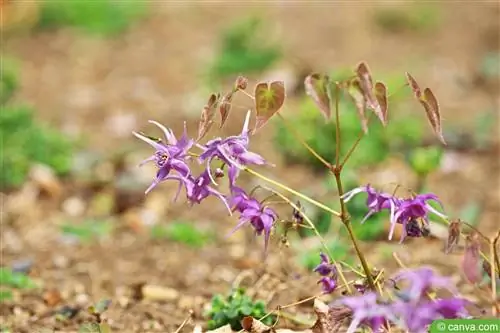
Watering and fertilizing
Fairy flowers need moisture. The pretty plants must not dry out at any time. They cannot tolerate hard water. It is best to use soft rainwater.
In the fall, elf flowers enjoy an additional dose of compost. Alternatively, you can cover the ground with leaves or grass clippings. This means the plants receive enough nutrients and can survive frosty temperatures without any damage.
Cutting and winter protection
Summer green elf flowers are cut back close to the ground in autumn. The wintergreen species benefit from pruning at the end of winter. Remove the old shoots just before the new leaves emerge.
Most Epimedium species are hardy. However, the sensitive roots of the deciduous Epimedium species should receive additional protection in winter. Cover the root area with a layer of leaves. This is how the beautiful plants get through the cold season safely.
Propagate
The best way to propagate the elf flower is to divide the clumps. To do this, cut off part of the plant with a sharp, clean spade. Dig a hole somewhere else, add some compost and place the plant there. Water them vigorously.
With a little patience, you can also grow some types of Epimedium from seeds. To do this, let the flowers fade. Small capsule fruits are formed which, when dried, contain some seeds. Fairy flower seeds have a striking fleshy seed coat.
Let the seeds dry on paper towels. Sow in bowls with potting soil in spring. Keep the substrate moist. The little plants slowly develop. Place the plants in small pots when they are strong enough. At the end of May you can move outdoors.
Note:
All parts of the elf flower plant, including its fruits and seeds, are slightly poisonous!
Pests
The decorative ground cover plants are unfortunately not only popular with hobby gardeners. Slugs like to eat the juicy shoots. Collect the snails regularly.
The black weevil is considered the most important pest. The adult beetle eats the leaves and its larvae feed on the roots. Nematodes help drive away the pest.
Diseases
If small reddish spots appear on the leaves of the fairy flower, this indicates a fungal disease. An infestation with Colletotrichum or Stagonospora fungi leads to these symptoms. Moisture promotes fungal infestation. Remove all affected plants and dispose of them safely with household waste. Avoid leaf wetness.
Water elf flowers from below if possible. Use the morning hours for watering so that the leaves can still dry.
Note:
If the leaves of the elf flower turn brown, the cause is usually natural. Many varieties sprout with red or brown leaves. Little by little they turn green. The foliage of the wintergreen species also turns brownish in autumn.
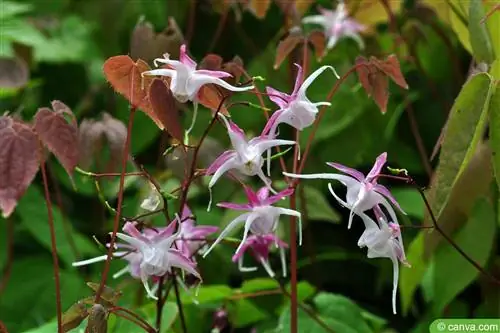
Usage
Fairy flowers have a permanent place in natural medicine. Epimedium extracts are used in the treatment of cancer. In traditional Chinese medicine, certain varieties are used to relieve thyroid disorders and high blood pressure.
Florists love elf flowers especially because of their heart-shaped leaves. They can be used all year round to create bouquets and arrangements. Cut off a few flower stalks during the flowering period. They look enchanting in the vase and retain their beauty for several days.

